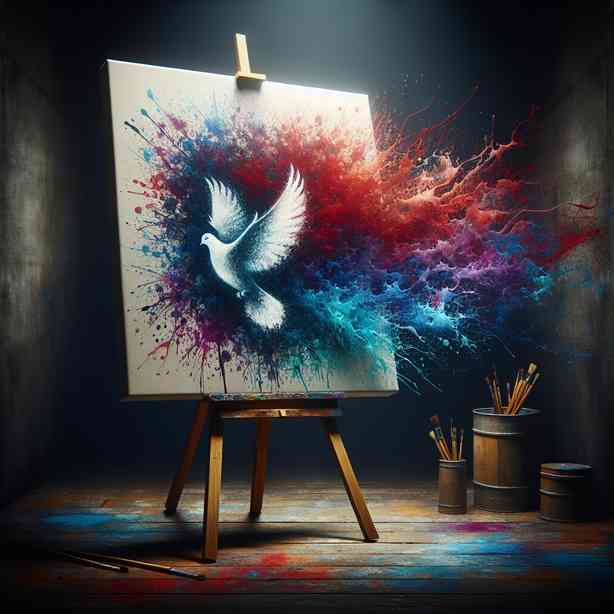
When Violence Becomes Art
Violence has been a part of human history for centuries, influencing various forms of expression, including literature, music, film, and visual arts. The intriguing relationship between violence and art often serves as a reflection of society’s deepest fears, conflicts, and struggles. From the earliest cave paintings to contemporary installations, artists have tackled the theme of violence in ways that provoke thought, stir emotions, and challenge audiences to confront their realities. In this exploration, we will delve into how violence transforms into art, the implications of this transformation, and the role it plays in society.
The historical context of violence in art dates back to ancient civilizations. Take, for instance, the murals of ancient Greece, which often depicted battles and mythical conflicts. These artworks didn’t merely serve as decoration; they were a means to convey the values, beliefs, and narratives of the society that created them. As we analyze these pieces, we realize that violence often represented a pivotal aspect of the human condition. The struggles portrayed were not just external conflicts but also internal ones. This duality of violence as both a physical and psychological phenomenon opens a gateway to understanding its resonance in modern art.
In the modern era, the relationship between violence and art grew even more complicated due to the rise of various artistic movements. The emergence of expressionism, for instance, marked a significant shift. Artists like Edvard Munch, renowned for his iconic painting “The Scream,” explored themes of existential angst, reflecting the psychological torment associated with both personal and societal violence. Munch’s works resonate with viewers, as they evoke a profound sense of empathy. Here, violence becomes not merely a subject but an emotion that echoes through time, transcending its origins to become a universal language of human suffering.
Contemporary artists have also responded to violence by directly engaging with modern societal issues such as war, crime, and systemic oppression. The works of artists like Ai Weiwei exemplify this trend. Known for his politically charged installations, Ai uses the medium of art to criticize government actions and advocate for human rights. His piece “Remembering” features thousands of children’s backpacks arranged in a way that commemorates the lives lost in a tragic earthquake in China. By channeling collective grief through art, Ai transforms violence into a poignant commentary on societal neglect. Thus, art serves as a powerful vehicle to bridge personal pain with collective trauma, allowing audiences to process and reflect on their experiences.
Moreover, visual art is not the only medium that channels violence. Literature and film have also played pivotal roles in exploring violent narratives. Writers like Cormac McCarthy, in novels such as “Blood Meridian,” illustrate the brutality of human existence in stark, unsparing language. McCarthy does not shy away from depicting violence; instead, he uses it to reveal deeper truths about morality, existence, and the human spirit. In cinema, compelling directors like Quentin Tarantino have infused narratives with stylized violence, using graphic visual storytelling to critique societal issues and challenge viewers’ perceptions of morality and justice. In both literature and film, violence catalyzes dialogue, prompting audiences to question their views on morality, justice, and the human capacity for cruelty.
However, the exploration of violence in art raises ethical concerns. As artists grapple with the implications of their work, they must consider the fine line between creative expression and glorification of violence. Critics often argue that sensationalized depictions of violence can numb audiences or desensitize them to real-world issues. It is crucial, therefore, for artists to remain cognizant of their responsibility when engaging with such themes. The goal should be to provoke thought and inspire change rather than to perpetuate cycles of violence.
The influence of social media and technology further complicates this relationship. Platforms like Instagram and TikTok have democratized art, allowing countless individuals to express themselves and share their interpretations of violence through various media. This shift also means that artworks can rapidly go viral, igniting discussions and sparking movements. Artists can now reach broader audiences, but this accessibility can lead to the commodification of violence in art. Hence, it becomes essential to critically engage with and interpret these representations rather than consume them passively.
In recognizing violence as a form of art, society is simultaneously confronted with its repercussions. Art holds the potential to foster empathy, allowing individuals to see the world through a lens of shared experience. This understanding can inspire action and change, as audiences are moved to address the issues presented to them through art. Organizations and communities often utilize art in activist movements, developing campaigns that highlight social injustices and advocate for reform. Art thus transforms from a mere reflection of violence to an instrument for social justice, promoting healing and reconciliation in the aftermath of conflict.
As we conclude our exploration of the intricate relationship between violence and art, it is vital to recognize that while violence has historically played a significant role in artistic expression, it also serves as a mirror to society’s complexities. The transformation of violence into art is not just about aesthetic representation; it invites us to confront uncomfortable truths, challenge societal norms, and engage with the realities that shape our world. The dialogues sparked by these artworks can foster understanding, encourage empathy, and inspire change.
Ultimately, the question remains: How do we, as a society, navigate the fine line between appreciating violence in art and promoting a culture that seeks peace and understanding? This reflection guides us in considering our responsibilities as both creators and consumers of art. By approaching the violent narratives present in artistic expression with a critical eye and a compassionate heart, we can begin to understand the multifaceted relationship between violence and art, traversing the complex terrain of human experience.


